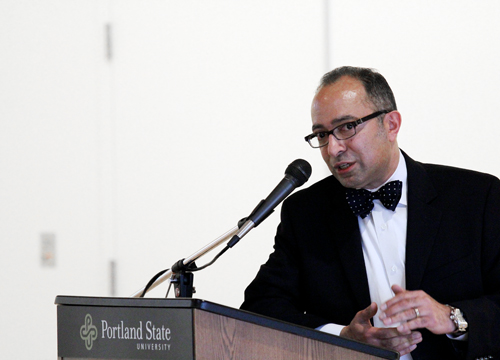Barmak Nassirian, associate executive director of the American Association of Collegiate Registrars and Admissions Officers, spoke to Portland State faculty, staff and students at a recent lecture on the state of higher education.
Lecture questions non-traditional universities

Barmak Nassirian, associate executive director of the American Association of Collegiate Registrars and Admissions Officers, spoke to Portland State faculty, staff and students at a recent lecture on the state of higher education.
During the lecture, “For-Profit Higher Education: Subprime goes to College,” Nassirian voiced his criticism of the current state of higher education policy. Previously, he appeared on a 2010 episode of Dateline, titled “Education Inc.,” and discussed his opinions on implications of the growth of for-profit institutions in higher education.
News entities such as ABC World News, The New York Times and Dateline have recently examined universities such as the University of Phoenix that run on a for-profit model as well as other nonprofit and for-profit distance-learning facilities such as Western Governors University.
Their findings have brought up many questions about higher education. What does a degree mean for students? What should it mean? In an exam-ination of these universities in comparison with traditional settings such as PSU, there are a few clear distinctions both sides make between costs, learning processes and methodology.
With issues of cost, accessibility and employability all at stake, these universities offer students alternative methods of education.
To receive a Bachelor of Arts degree in English from the University of Phoenix, the cost of attendance for one year would be $10,840 for tuition and materials. The cost per credit hour would be $420. In order to obtain such a degree in Portland, the courses would have to be taught entirely online.
The cost for one year of enrollment at 12 credits per term at PSU would be $6,532.80 for residents and $18,708 for non-residents. The cost per credit hour would be $136.80 for residents and $475 for non-residents.
WGU offers degrees using entirely online courses. The cost for attending WGU does not vary depending on credit hours. Instead, students pay a flat rate of $2,890 for six months of classes toward a teaching, information technology or business degree. Other programs, such as a master’s degree in business or nursing, can cost up to $4,250 for one six-month “term.” WGU operates as a nonprofit university and doesn’t maintain a physical campus.
“WGU is different in two important ways. First, WGU uses a competency-based learning model that allows students to earn their degrees by demonstrating what they know and can do rather than spending time in class to accumulate credit hours,” said Joan Mitchell, director of public relations at WGU.
“The second difference is the use of technology to facilitate learning. Technology has increased the productivity of nearly every industry except education, where it is most often an add-on cost and not used to change or improve teaching and learning,” she said.
PSU Assistant Professor Jennifer Schuberth expressed concern that these low costs “put pressure on places like PSU to do it cheaper.”
Other professors are also concerned about the amount of federal financial aid going to these universities. The concern is that for-profit universities are operating using federal grant money that could be used to support state and private universities. Nassirian said that these institutions “target low-income people when they don’t have their own money to offer, but they have vouchers worth thousands of dollars.”
“About 79 percent of our students receive some type of financial aid (Pell grants, scholarships, student loans),” Mitchell said.
According to a 2010 report published by the U.S. Senate’s Health, Education, Labor and Pensions Committee, of the 15 for-profit schools they examined, “eight schools more than doubled the amount of Pell grant dollars they received just between 2006 and 2009, with three more nearly doubling. At least two companies have seen increases of about 85 percent in Pell grant funding just between fiscal year 2009 and 2010. These increases, from $143 million to $266 million and $193 million to $358 million, respectively, have significant implications for the federal government funding these grants.”
Accessibility is another major issue in the current college climate. Universities like WGU and the University of Phoenix offer students an opportunity to obtain a degree while working or raising a family.
“Students increasingly want accelerated study at convenient times and places that are geared toward landing a job. Students can start a program at University of Phoenix immediately, whereas at traditional university they may have to wait for the next semester to roll around,” said Rick Castellano, University of Phoenix director of public affairs.
The greatest issue that Nassirian sees in these universities is their lack of legitimate accreditation. “How do we help people connect the dots?” he asked.
Nassirian explained that the process through which schools and universities become accredited can be very complex, but with the right resources the process can be completed. Universities then have access to federal and state funding. “These are credential agencies rather than a university,” he said.
Castellano defended University of Phoenix, saying, “University of Phoenix consistently provides a quality education to non-traditional students. The university offers more than 100 degree programs at the associate through doctoral levels. The university is accredited by the Higher Learning Commission and holds the same level of institutional accreditation as America’s top schools.”
Mitchell also said that WGU provides students with a solid education. “All graduates have demonstrated that they’ve mastered the competencies for their degree fields by completing assessments, which take several forms—objective exams, performance tasks, portfolios, projects, etc. As part of their competency assessment, students in teacher licensure programs complete student teaching; those in nursing programs do clinical rotations,” she said.






